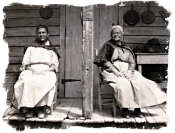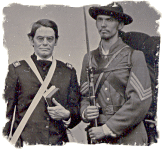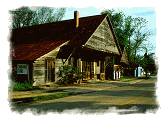|
A dark ribbon of water winds
lazily through fertile farmlands, its path lined
with red soil, lush stands of river cane, and
majestic live oak and pecan trees. The waterway
meanders from town to town, and
plantations,
homes, and churches mark life’s stopping points
along its banks.
Cane River,
an oxbow lake that once was the primary channel of
the mighty Red River, defines the region today,
just as it has for centuries. The stories of Cane
River’s people are brimming with the
juxtapositions that comprise our nation’s
history—conquest and colonialism, militarism and
peace, wealth and poverty, slavery and freedom.
The landscape
of
Cane River
has been the focal point for American Indian
settlements, colonial forts, and Creole
plantations.
The river itself was a major trade thoroughfare,
one that was crossed by overland trade routes. It
was at this crossroads that the Natchitoches band
of Caddo Indians dwelled. The prospect of trade
and alliance with American Indians brought
European colonial powers to the area, and this
region soon became the intersection between French
and Spanish realms in the New World. The French
established
Fort Saint Jean Baptiste
in 1714. Shortly thereafter, the Spanish responded
by building the presidio known as
Los Adaes
fifteen miles to the west. Settlement spread from
these early outposts, and the town of
Natchitoches
grew up around
Fort Saint Jean Baptiste
to become the most prosperous town in the region.
 As
countries came together in this place, so did
cultures. American Indians were joined by European
settlers, who imported large numbers of enslaved
Africans to farm the land. The interaction of
these groups led to the development of a
distinctive
Creole
culture, a culture that cut across racial
categories and drew from many traditions but
remained grounded in French colonialism and
Catholicism. As
countries came together in this place, so did
cultures. American Indians were joined by European
settlers, who imported large numbers of enslaved
Africans to farm the land. The interaction of
these groups led to the development of a
distinctive
Creole
culture, a culture that cut across racial
categories and drew from many traditions but
remained grounded in French colonialism and
Catholicism.
A thriving
agricultural economy had developed along the banks
of the river by the time the region was joined to
the United States in the 1803 Louisiana Purchase.
Natchitoches,
the oldest permanent European settlement in the
Louisiana Purchase territory, was the region’s
commercial center. Downriver from the town, in the
areas known as Côte Joyeuse (‘Joyous
Coast’) and Isle Brevelle, large and small
plantations
produced indigo, tobacco, and later cotton.
 The
Civil War and its aftermath brought great economic
devastation and cultural change for the residents
of the
Cane River
region. Tenant farming and sharecropping replaced
slavery, exchanging one labor-intensive system for
another. After World War II, mechanized farming
permanently supplanted the old agricultural
practices that depended on human labor in the
fields. As a result, many people migrated to urban
centers, leaving the fields behind. The
Civil War and its aftermath brought great economic
devastation and cultural change for the residents
of the
Cane River
region. Tenant farming and sharecropping replaced
slavery, exchanging one labor-intensive system for
another. After World War II, mechanized farming
permanently supplanted the old agricultural
practices that depended on human labor in the
fields. As a result, many people migrated to urban
centers, leaving the fields behind.
 This
is the complex past that is etched indelibly on
the landscape, in the architecture, and in the
myriad cultural traditions that have been passed
down through generations. In 1994, Congress
established the
Cane River National Heritage
Area in
recognition of the history and culture of this
unique region. The heritage area is a nationally
significant cultural landscape, a place in which
the river and the people who have dwelt along its
banks through time come together in a history that
contributes to the American experience. This
is the complex past that is etched indelibly on
the landscape, in the architecture, and in the
myriad cultural traditions that have been passed
down through generations. In 1994, Congress
established the
Cane River National Heritage
Area in
recognition of the history and culture of this
unique region. The heritage area is a nationally
significant cultural landscape, a place in which
the river and the people who have dwelt along its
banks through time come together in a history that
contributes to the American experience.
|

